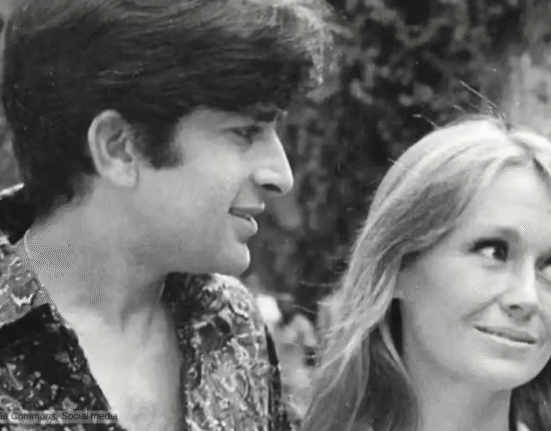Today, we recognise Sardar Malik as the father of Anu Malik, a notable music director. However, not many are familiar with his own body of work and the excellence he brought to the industry. Sardar Malik’s story is fascinating—that of an outsider who worked hard to make his mark.
Early Life And Training
Born in Kapurthala on January 13, 1930, Sardar Malik had an early interest in singing and dancing. He applied to Uday Shankar’s India Cultural Centre in Almora, where eminent personalities like Sankaran Namboodri (Kathakali), Kandappa Pillai (BBharatanatyam), Ambi Singh(Manipuri), and Ustad Allauddin Khan (music) were teaching.
The center was a hub for artists and dancers, including Guru Dutt, Shanti Bardhan, Simkie, Amala, Satyavati, Narendra Sharma, Ruma Guha Thakurta, Prabhat Ganguly, Zohra Sehgal, Uzra Butt, Mohan Sehgal, Lakshmi Shankar, Shanta Gandhi and Pt. Ravi Shankar. During his time at Almora, he became a favorite student of Uday Shankar, excelling in Kathakkalli, Bharatnatyam, and Manipuri dance, eventually becoming a choreographer. He also learned music from Ustad Allauddin Khan.
After leaving the academy, Sardar Malik and Mohan Sahgal, his fellow student, ventured into choreography for a film. However, the collaboration did not work out, leading Mohan Sahgal to pursue film direction while Sardar Malik turned to singing and music direction.
The Musician Sardar Malik
In 1947, Sardar Malik got his big break as a music composer in Jayant Desai’s production, “Renuka.” For the film, he not only composed two songs but also lent his voice to two solos and a duet with Zohra. Interestingly, Sardar Malik played a pivotal role in launching Raj Khoshla‘s career. Raj, who had arrived in Bombay from Ludhiana with dreams of becoming a singer, received his first opportunity in the industry thanks to Sardar Malik’s support. This instance not only marked the beginning of Sardar Malik’s musical journey but also highlighted his generosity in giving others a chance to pursue their dreams in the world of entertainment.

Next comes Raaz (1949), in which Mohan Sahgal also acted, which has songs by the progressive poet, Meera ji. Malik also sang a solo, So ja so ja Amrika se pariyan aaiye and three duets with Veenapani Mukharjee in the film. He goes on to give music to films like
- Laila Majnu (1953) starring Nutan and Shammi Kapoor
- Thokar (1953) starring Shyama and Shammi kapoor.
Thokar (1953) was the film that brought Sardar Malik into prominence, the song “Aye ghame dil kya karun” written by revolutionary poet “Majaz” and sung by Talat Mehmood becomes a rage and remain popular even today.
In 1954, Sardar Malik composed for Chor Bazar and Mohan Sahgal’s film Aulad. In 1955 comes Ab-E-Hayat which has Hemant Kumar‘s evergreen “Main ghareebon ka dil”. More films from this period are Chamak Chandni (1957), Taxi 555 (1958), Maa Ke Aansoo (1959) & Maharani Padmini (1959)
Saranga Man Sardar Malik
In 1960, he gave the biggest musical hit of that year, Saranga, starring Sudesh Kumar and Jayshree Gadkar. The film have chartbusters like Saranga teri yaad mein, nain hue bechain, Haan deewana hun main ghum ka mara hua (Mukesh), Lagi tumse lagan saathi chhute naa (Lata-Mukesh), Piya kaise milun tumse mere paun padi zanjeer (Lata-Rafi), Likh de piya ka naam sakhi re (Suman Kalyanpur) and Saath jiyange saath marange (Rafi).
The same year, he did Sohrab Modi’s Mera Ghar Mere Bachche which has Baharon se puchho nazaron se puchho (Mukesh-Suman Kalyanpur), Chanda ke desh mein rehti ek rani (Mukesh) and Peena haram hai to nighaen milake pee (Asha).
Despite giving successful music, Sardar Malik never becomes a lister, his work reduced over time. His son Anu Malik once said, “Saranaga had an unknown actor — Sudesh Kumar, Had it been filmed on Raj Kapoor, dad would have become a superstar composer too. You needed stars like Dilip Kumar, Raj Kapoor, Dev Anand… to be the face of your song. That’s why I strove to compose for the Khans.“

The same year, he did Sohrab Modi’s Mera Ghar Mere Bachche which has Baharon se puchho nazaron se puchho (Mukesh-Suman Kalyanpur), Chanda ke desh mein rehti ek rani (Mukesh) and Peena haram hai to nighaen milake pee (Asha).
Later Work
Despite giving successful music, Sardar Malik never becomes a lister, his work reduced over time. His son Anu Malik once said, “Saranaga had an unknown actor — Sudesh Kumar, Had it been filmed on Raj Kapoor, dad would have become a superstar composer too. You needed stars like Dilip Kumar, Raj Kapoor, Dev Anand… to be the face of your song. That’s why I strove to compose for the Khans.“
In the ’60s, he did some B-grade films but the quality remains the same, like – Ud ud jaye anchal (Superman), Hum apne ghum ko saja kar bahar kar lenge (Madan Manjari) and Sun chand meri dastan (Naag Jyoti). In 1963 film Bachahpan (1963) Rafi sang his favourite number, Mujhe tumse mohabbat hai magar main kah nahi sakta and Mere naina mad ke payale (Suman Kalyanpur). His last few films were Roop Sundari (1964), Jantar Mantar (1964) and Paanch Ratan (1965).
Personal Life
People say he became a victim of the fierce rivalry and fight between Sahir and Lata, as Lata thinks he is taking sides with Sahir Ludhiyanvi. We don’t know what the truth is, but his lack of work made him a bitter man and He reportedly threw all his records in the sea out of frustration.
Despite having friends like Sahir and Hasrat Jaipuri (Malik’s wife, Bilqis, was the sister of Hasrat Jaipuri), and also having worked with Rafi, Lata and Geeta, he never went to anyone for help. In 1977, actor Premnath approached him for his film GianiJi, the film nor its music have had much impact.
Sardar Malik passed away in Bombay on January 27, 2006, His legacy extends through his sons, Anu Malik, Daboo Malik, and Abu Malik, and his grandsons, Amaal Mallik and Armaan Malik.
Sardar Malik on IMDB








